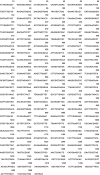A case of a renal abscess caused by Salmonella bareilly in a previously healthy boy
- PMID: 35272623
- PMCID: PMC8908585
- DOI: 10.1186/s12879-022-07229-1
A case of a renal abscess caused by Salmonella bareilly in a previously healthy boy
Abstract
Background: Renal abscesses are relatively uncommon in children, and usually due to Gram-negative rods or Staphylococcus aureus, whereas abscesses caused by Salmonella are very rare.
Case presentation: We present the case of a previously healthy 10-year-old boy who had a renal abscess due to Salmonella bareilly. He responded well to treatment with antibiotics, and computed tomography (CT)-guided drainage of the abscess. His blood, urine and abscess aspirate cultures were sterile, but a broad-range 16S rDNA polymerase chain reaction (PCR) assay of the aspirate followed by analysis of four Salmonella genes (fliC, fliD, sopE2, and spaO) identified S. bareilly as the causative agent.
Conclusion: To the best of our knowledge, this is the first report of renal abscess caused by S. bareilly.
Keywords: Broad-range 16S rDNA PCR; Renal abscess; Salmonella bareilly; Single-nucleotide polymorphism.
© 2022. The Author(s).
Conflict of interest statement
No competing interests to declare.
Figures



References
-
- Bridges RF, Scott WM. A new organism causing paratyphoid fever in India. J Roy Army Med Corps. 1931;56(9):241.
Publication types
MeSH terms
LinkOut - more resources
Full Text Sources
Medical

